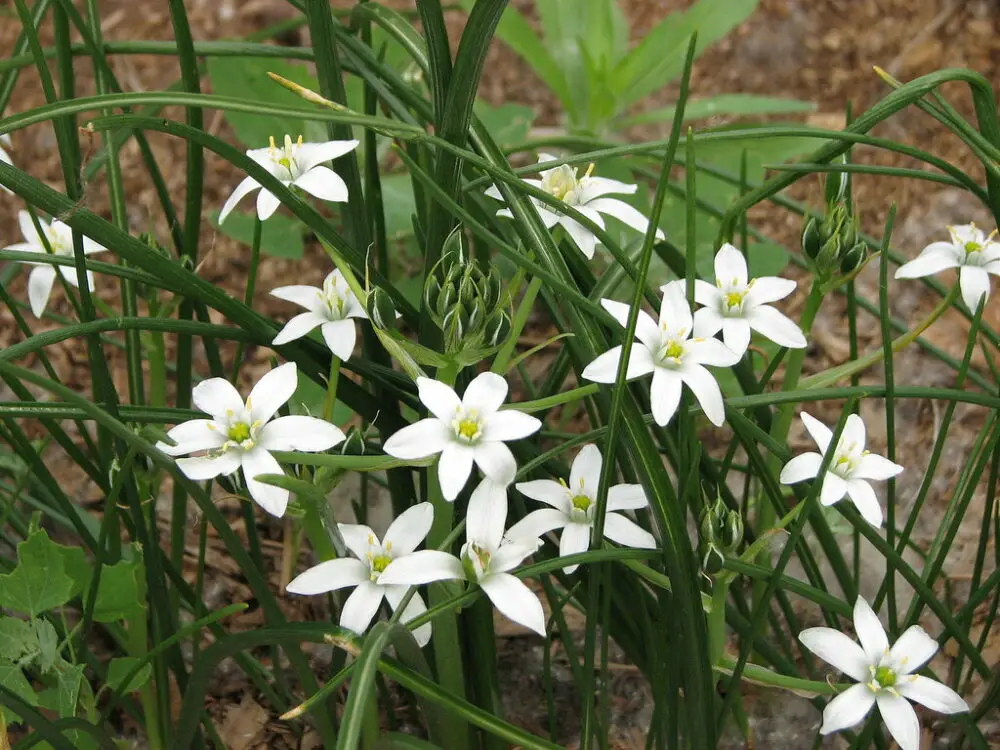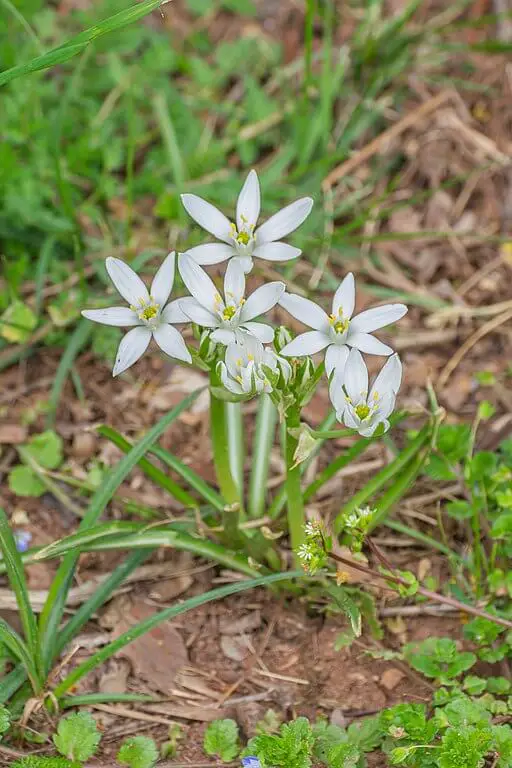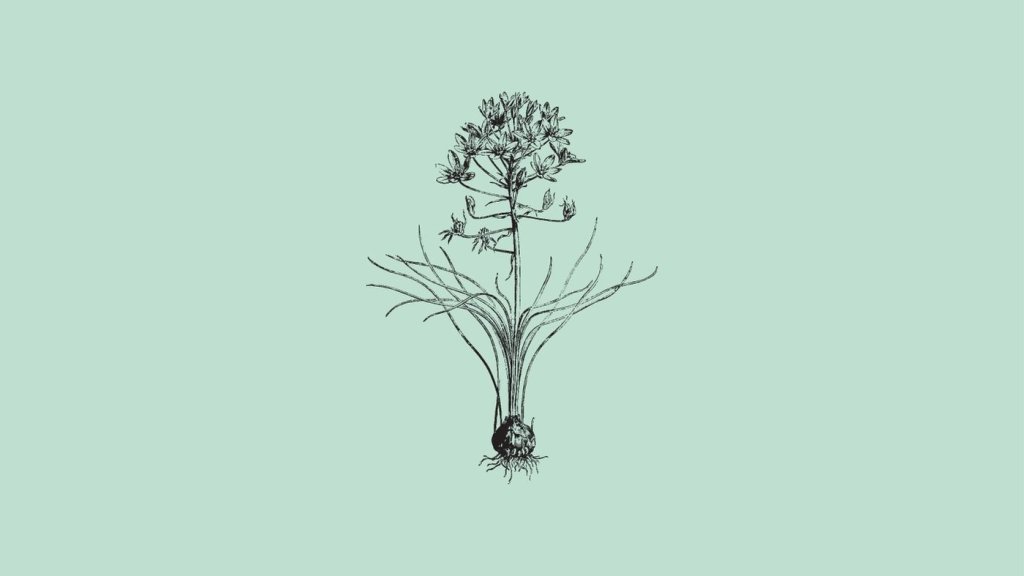Ornithogalum umbellatum is a widespread bulbous perennial; you probably know it as the Star of Bethlehem flower. In the US, it is often used as an ornamental garden plant. Although it's not edible, the Star of Bethlehem is a beautiful yet underrated wildflower.
Cute, star-shaped, white flowers grow in favorable conditions. They often spread rapidly through offsets, forming a carpet of low-growing foliage and standing out against the surrounding plant life.
Check out the below if you want to know why pollinators and foragers love this wildflower.
Ornithogalum Umbellatum: Plant Profile
You may not know Ornithogalum umbellatum by its scientific name, but you may know it by its more common names, including;
What Are You Foraging For Right Now?
We're thrilled to hear your ideas. What would you like to submit today? Feel free to share your thoughts and experiences with us.
- Garden Star of Bethlehem
- Nap-at-noon
- Eleven-o’clock lady
- Grass lily
- Sleepy dick
Folklore rumors suggest that the Ornithogalum umbellatum originally grew from the Star of Bethlehem fragments, hence its horticultural name.
As a species belonging to the Ornithogalum genus, the Star of Bethlehem is a perennial bulbous, flowering plant. This wildflower is part of the Asparagaceae family, otherwise known by its synonym, the asparagus family.
Living close to the ground, the Ornithogalum is a low plant. It produces showy white flowers that sit in a stellate pattern, with a bloom time of mid to late spring. This wildflower sprouts in clusters of basal linear leaves.
These conspicuous white flowers are late bloomers, opening later in the day. Of course, that’s where some of its synonyms come from.
When this plant is closed, you’ll notice it has a green stripe on the outside, making it pretty easy to distinguish.
When growing conditions are favorable, flowering usually occurs in April and May. During this time, the Star of Bethlehem flower decorates the ground with carpets of low-growing foliage. These carpets look heavenly, topped with many starry white flowers.

Where Does it Grow?
The Star of Bethlehem flower is a native plant in the common climates of most of central and southern Europe. It lives in Ireland, the United Kingdom, the West of Portugal, the South of Italy, the North of France, the East of Turney, and the Levant.
The sleepy dick even goes as far as Northern Africa and southwest Asia as a native plant.
In places like North America, you’ll probably find the O. umbellatum used as an ornamental garden plant.
To the upset of horticulturists, this plant is now considered a noxious weed invading gardens, lawns, and no-till agricultural land. It can be challenging to eradicate.
The Star of Bethlehem is a hardy white flower, tolerant of both soil type and shade.
Foragers in these locations should look out for damp habitats, including rivers, streams, sunny soil banks, and other lower wet areas of pastures.
It also looks great as an underplant for deciduous trees and shrubs.
Is the Star of Bethlehem a Wildflower?
Although it’s not edible, the Star of Bethlehem flower is an underrated wildflower that needs to feature in everyone’s plant database.
The Ornithogalum umbellatum is straightforward to plant and establishes quickly in a spring bloom time meadow. The white, star-shaped flowers also offer a stunning scene, like a shower of snowflakes.
But don’t be disappointed if you’re out foraging at the wrong time. The summer snowflake flowers only open in full sun. Usually, you can spot a full bloom of flowers in late spring to early summer, like April to May.
Is the Star of Bethlehem Poisonous?
Unfortunately, this isn’t one of those edible wildflowers; it contains a level of toxicity. All of the Ornithogalum umbellatum, but especially the bulb and flowers, are poisonous.
They contain cardiac glycosides, in particular convallatoxin and convalloside. Both of these poisons are toxic to animals and humans.
If you see the Star of Bethlehem flower, leave it alone, and don’t let your pets near it. Excessive contact can lead to skin irritation.
Symptoms of ingestion poisoning include:
- Salivation
- Nausea
- Vomiting
- Diarrhea
- Shortness of breath
- Pain, burning, and swelling in the lips, tongue, and throat.

Ornithogalum Umbellatum: Medicinal Uses
Some people use the Star of Bethlehem flower for its medicinal purposes. For example, its essences are sold as medicinal remedies.
Individuals reportedly take the Star of Bethlehem in essence form to:
- Improve heart function
- Decrease lung congestion
- Decrease water retention in the legs
However, formal scientific studies are needed to determine if these benefits are common in the masses.
The Best Way to Plant Ornithogalum Umbellatum
When planting your Ornithogalum umbellatum, ensure it has access to full sun or partial shade, easily-draining soil. To get a successful bloom time the following year, ensure you plant in the fall.
Because these gorgeous summer snowflake flowers are sun lovers, they grow pretty low to the ground.
Horticulturists love this wild plant because the bulbs are super hardy, disappearing into bulbs under the soil in winter. It needs no attention during the winter.
Plant the bulbs about 3 inches deep (8 cm) and 4 inches apart (10 cm) per 10 square feet. Sunny, south-facing banks usually look the best, significantly if they’re raised so you can enjoy looking at them.
You can plant this wildflower in light grass, but be sure not to cut the grass-like leaves off until they are yellow.
Choosing suitable soil is equally important. The Ornithogalum genus thrives best when planted in well-draining, medium moisture, organically rich soil.
This goes for any of the species, whether you’re looking to plant the Ornithogalum pyrenaicum (Pyrenees Star of Bethlehem), the Ornithogalum nutans (the drooping Star of Bethlehem), or the Ornithogalum umbellatum (Star of Bethlehem).

Ornithogalum Plant Care Tips
A few care tips can help your Star of Bethlehem flower to be healthy during dormancy, whether inside or outside.
- Prune the foliage back when the foliage begins to yellow and die. This usually happens in late summer, shortly after flowering. You’ll want to prune back an inch above the soil line.
- Always use a clean pair of scissors or secateurs when pruning.
- Choose a dark location for the potted bulb to allow for low humidity and temperatures around 10°C (50°F). Do this for a couple of months.
- Never overwater. Water sparingly in dormancy. You want to keep the bulb going; you don’t need it to flower. Don’t forget root or pythium rot can result from too much moisture.
- Weakly fertilize the plant with a ‘Cacti & Succulent’ labeled feed. When the foliage starts to re-emerge during spring, combine this with increased water feeds per week.
- Again, when the foliage starts to remerge, relocate your wildflower to a sunny location with little to no direct sunlight. Doing so allows your plant to acclimate to its new surrounding.
Hopefully, you now know everything you need to know to spot, grow and care for Ornithogalum umbellatum, otherwise aptly named the Star of Bethlehem.
Getting into the great, wet outdoors in search of edible plants, herbs, fruits and fungi is one of Sarah’s favorite outdoor pursuits. She thinks there’s nothing better than combining her passion for hiking with the start of the foraging season. Sarah’s definitely not afraid of a little rain and dirt, it’s all part of the fun.

